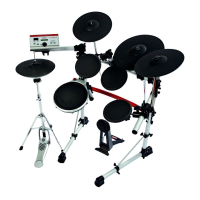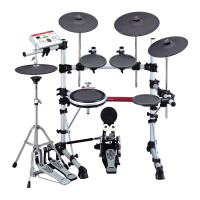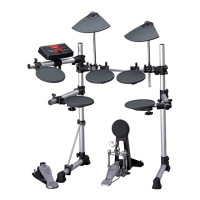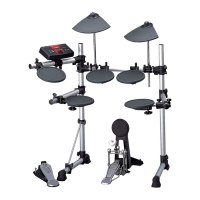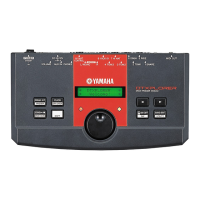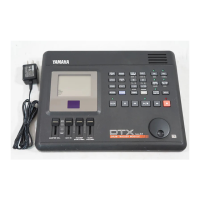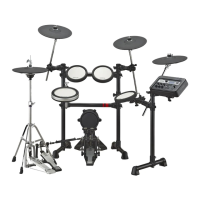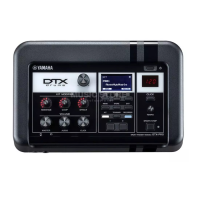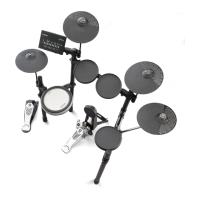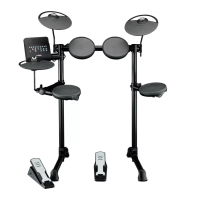Do you have a question about the Yamaha DTXPRESS and is the answer not in the manual?
Information regarding the product's battery usage, safety, and replacement.
General warnings about product usage, placement, and potential hazards.
Guidelines for the proper disposal of the product and its components.
Information about locating the product's nameplate for identification purposes.
Critical safety precautions to avoid serious injury or death from electrical shock, fire, or other hazards.
Important precautions to prevent physical injury or damage to the instrument or property.
Instructions and warnings for replacing the internal backup battery to maintain data.
Advice on saving user data to an external device to prevent loss due to malfunctions.
Guide to understanding basic functions and precautions before using the DTXPRESS.
Section detailing specific functions and operations of the DTXPRESS.
Contains supplementary information like specifications, error messages, and lists.
Details about the DTXPRESS's trigger inputs, pad types, and drum kit memory.
Information on the DTXPRESS's sound engine, voice capabilities, and reverb.
Overview of the DTXPRESS's sequencing features for song creation and practice.
Description of the DTXPRESS's connectivity options including MIDI and AUX IN.
Overview and explanation of the DTXPRESS's front panel controls, buttons, and display.
Details on the DTXPRESS's rear panel connectors, jacks, and switches.
Instructions for connecting drum pads to the DTXPRESS trigger input jacks.
Guide on attaching drum triggers to acoustic drums and connecting them.
How to connect audio equipment for sound reproduction via output jacks.
Instructions for connecting MIDI devices for data exchange and control.
Methods for connecting the DTXPRESS to a computer via serial or MIDI interface.
How to connect audio players via the AUX IN jack for practice.
Instructions for connecting the AC adaptor for powering the DTXPRESS.
How to connect headphones for monitoring the DTXPRESS output.
Steps to select and listen to preset songs for practice and familiarization.
How to choose and activate different preset drum kits for playing.
Adjusting the volume level for individual pads within a selected drum kit.
Assigning different instrument voices to specific drum pads in a kit.
Adjusting the reverb effect level applied to drum kit voices.
Procedures for saving modified drum kit and voice settings to memory.
Steps to power on the DTXPRESS and its connected devices correctly.
How to produce sound by hitting pads and adjusting the master volume.
Selecting and auditioning different preset drum kits for playing.
Adjusting individual pad volumes and panning using specific controls.
Adjusting EQ settings for the audio output to modify sound quality.
How to activate and control the metronome's tempo, beat, and volume.
Using the Groove Check feature to evaluate and improve rhythmic accuracy.
How to choose and listen to preset songs for practice and familiarization.
Starting song playback and basic playback controls like stop and repeat.
Using the Rhythm Mute function to isolate specific drum parts during playback.
Adjusting the volume balance between song accompaniment and drum part.
Modifying the tempo of the selected song for practice.
Using the metronome click along with song playback for timing.
Customizing the metronome click sound, voice category, and number.
Selecting a different drum kit to be used with a particular song.
How to change songs without altering the current drum kit selection.
Muting specific drum sounds within a song for focused practice.
Overview of the recording system, user songs, tracks, and data handling.
Choosing a user song number (96-127) to record performance data into.
Configuring parameters like measures, record mode, track, tempo, and quantize.
Initiating the recording process with a two-measure count after setting conditions.
Playing back recorded songs and changing drum kits for playback.
Clearing previously recorded data in tracks or the entire song to re-record.
Adding a second track to the recorded song, maintaining the same number of measures.
Assigning a custom name (up to 8 characters) to the recorded song.
Steps to select and assign drum voices to pads, including voice category and number.
Adjusting the volume level for individual drum voices and balancing layers.
Adjusting the stereo pan position for drum voices within the stereo field.
Modifying the pitch of drum voices using coarse and fine tuning adjustments.
Adjusting the decay time and filter cutoff frequency for drum voices.
Saving the custom drum voice and kit settings to a user drum kit memory.
Assigning a custom name to the newly created drum kit.
Restoring all DTXPRESS internal settings to their factory preset condition.
Details on pad settings, sensitivity adjustments, and connectivity options.
Configuring the DTXPRESS's internal digital reverb effect type and time.
Parameters affecting drum voice behavior, including layers, reverb, and alternate groups.
Global settings affecting the tone generator, like EQ, tuning, and reverb bypass.
Parameters controlling song playback, tempo, and metronome synchronization.
Various additional functions and pad control assignments.
How to use MIDI for communication and control with external devices.
Methods for connecting the DTXPRESS to a computer via serial or MIDI interface.
Diagram and explanation of how signals are processed within the DTXPRESS.
How trigger signals from pads are managed and processed through buffers.
Explanation of the Trigger Setup mode for pad sensitivity and function adjustments.
Details on setting drum kit voices, tuning, reverb, and saving custom kits.
Information about the DTXPRESS's voice capabilities, drum/keyboard voices, and polyphony.
Details on the DTXPRESS's preset and user songs, including tracks and MIDI channels.
How MIDI and TO HOST jacks are used for data exchange with external devices.
General procedures for entering modes, navigating pages, and setting parameters.
How to navigate between pages within different modes using PAGE buttons.
How to select and move the cursor to parameters for editing using SEL buttons.
How to adjust parameter values using the VALUE buttons.
Steps to access and navigate the Drum Kit Play mode displays.
Selecting the drum kit and song for playback and editing.
Selecting trigger setups and setting song tempo for playback.
Setting the repeat playback mode for songs.
Setting the metronome beat for song playback and practice.
Adjusting the click tempo for metronome quantization accuracy.
Selecting songs and muting specific drum parts during playback.
Details on the Groove Check function for evaluating rhythmic accuracy.
Structure of songs, including header data and sequencer tracks (MIDI channels 1-16).
How main and pad songs are played and triggered by pads.
Using the metronome function independently or with songs for practice.
Instructions for selecting, starting, stopping, and controlling song playback.
How to play and stop pad songs that are assigned to specific pads.
Features for controlling song volume, metronome settings, and playback behavior.
Muting drum parts or specific MIDI channels during song playback.
Settings for song tempo synchronization and click voice behavior during playback.
Guide to recording performances into user songs using the sequencer.
Overview of the editing capabilities for trigger inputs and pad settings.
Steps to access and navigate the Trigger Setup Edit mode.
Specific settings for each individual pad input (1-10), like pad type and gain.
Common settings applicable to all pad inputs, like input exchange and setup name.
Setting the type of pad or trigger sensor connected to a trigger input jack.
Adjusting input sensitivity (gain) and minimum velocity settings for pads.
Setting the MIDI velocity curve for pad sensitivity and dynamic response.
Preventing double triggers and cross-talk for input jacks using rejection settings.
Preventing cross-talk between two specified input jacks using specific rejection.
Copying trigger setup data from one input jack to another.
Assigning pads to increment/decrement drum kit numbers via pad hits.
Switching trigger signals between input jacks 1 and 9/10.
Changing the name of the currently edited trigger setup.
Overview of editing capabilities for drum kit voices, layers, and parameters.
Steps to access and navigate the Drum Kit Voice Edit mode.
Setting the voice for each pad input source and layer, including number and name.
Common settings for 2 layers of pad input sources, like cross fade and reverb send.
Adjusting the internal reverb effect type, time, and master return level.
Copying MIDI transmit settings and drum kit voice settings between sources.
Common settings for the entire drum kit, like overall volume and hi-hat sensitivity.
Assigning the voice (drum voice) for each input source and layer.
Setting the volume and stereo pan position for each voice layer.
Adjusting the pitch (coarse and fine tuning) for each voice layer.
Setting the volume balance between 2 layers of a drum voice.
Adjusting drum voice decay and filter cutoff frequency.
Setting the MIDI note number for each voice layer.
Setting MIDI transmit channel and gate time for voice layers.
Setting velocity (volume) cross-fade between 2 layer voices.
Setting the reverb send level for voice layers.
Setting alternate groups and key assign modes for voices.
Setting the Hold Mode for voice layers.
Deciding whether to recognize MIDI key off messages for voice layers.
Using pads to control other functions like pad song playback or metronome.
Settings for pad song playback control via trigger input.
Setting the type and time of the reverb effect for drum kits.
Adjusting the overall reverb return level for the entire DTXPRESS system.
Setting MIDI program channel, bank select MSB/LSB for drum kits.
Setting MIDI Control Change Volume and Pan for drum kits.
Copying drum kit voice settings from one input source to another.
Setting the overall volume level for the drum voice.
Setting the overall reverb send level for the drum voice.
Setting the foot controller sensitivity for the HI-HAT CONTROL jack.
Switching the main song automatically when the drum kit is switched.
Changing the name of the currently selected drum kit.
Steps to access and navigate the Song Job mode for editing user songs.
Setting the tempo and repeat playback mode for user songs.
Changing voices (program change) and bank select for MIDI channels in songs.
Adjusting volume and pan settings for MIDI channels within a song.
Copying song data from one user song to another, replacing existing data.
Correcting timing inaccuracies in recorded song tracks using note length accuracy.
Clearing data from a specific track within a user song.
Mixing sequence data from tracks 1 and 2 into track 1.
Erasing all data from both tracks of a user song.
Changing the name of the currently selected user song.
Steps to access and navigate the Utility Mode for system and MIDI settings.
Settings affecting the overall DTXPRESS system, including learn mode and factory set.
Settings related to MIDI and TO HOST jack functions, like bulk dump and MIDI mode.
Settings specific to the DTXPRESS sequencer (song) functions like click voice.
Settings for the DTXPRESS tone generator, including EQ, tuning, and volume.
Used to edit the User Drum Map, assigning voices to MIDI note numbers.
General procedure for changing settings within Utility Mode using buttons.
Selecting pads for editing in Trigger Setup/Drum Kit Edit modes.
Prohibiting reception of signals from pads to prevent accidental triggering.
Setting how ACCOMP. VOL and CLICK VOL knobs function for different modes.
Displaying the last edited page upon entering a mode.
Setting hi-hat controller data for foot splash detection and closed point.
Restoring all DTXPRESS internal settings to their factory preset condition.
Transmitting DTXPRESS data via MIDI OUT or TO HOST jack for backup.
Enabling/disabling reception of MIDI channel 10 program change/channel events.
Enabling/disabling reception of PC/SysEx messages from all MIDI channels.
Creating a table to link program changes to specific drum kits.
Setting the MIDI mode (native or GM) for tone generator events.
Setting MIDI device number and switching local control ON/OFF.
Merging external MIDI data with internal data for output via MIDI OUT jack.
Setting intervals between MIDI data packets for bulk dump to prevent overflow.
Setting whether hi-hat controller events are transmitted from MIDI OUT/TO HOST.
Transmitting multi-port messages received from the TO HOST jack via MIDI.
Setting the click voices used for the metronome sound.
Setting the pitch for each of the 3 click voices.
Setting the MIDI Note Number for each of the 3 click voices.
Enabling/disabling transmission/reception of system real-time messages.
Turning the 2-bar countdown before song playback ON or OFF.
Synchronizing DTXPRESS sequencer clock with an external device's clock.
Setting whether song tempo changes to default or remains unchanged.
Setting whether click voice sounds automatically during song playback.
Setting the master equalizer (2-band shelving type) for the tone generator.
Setting the master tuning of the tone generator.
Setting the overall volume level of the tone generator.
Deciding whether to bypass the system effect's reverb.
Assigning a drum voice for each MIDI note number.
Setting volume and pan for each drum voice assigned to a MIDI note number.
Setting the pitch for each drum voice assigned to a MIDI note number.
Setting the volume balance between 2 layers of a drum voice.
Setting drum voice decay and filter cutoff frequency.
Setting the reverb send level for each drum voice assigned to a MIDI note number.
Setting alternate group and key assign mode for drum voices.
Deciding whether to recognize key off messages for drum voices.
Copying preset drum map settings to a user drum map.
Technical specifications of the DTXPRESS module.
List of possible error messages and their meanings.
Guides users through common problems and their solutions.
A comprehensive list of all available drum voices categorized by type.
List of General MIDI compliant keyboard voices.
A list of preset drum kits and their assigned pad settings.
A list of all preset songs available on the DTXPRESS.
A list of available trigger setup presets for pad configuration.
Details on MIDI data format used by the DTXPRESS for communication.
Chart detailing MIDI message transmission and reception capabilities.
Alphabetical index to help locate specific topics within the manual.
Troubleshooting steps for no sound or trigger input issues.
Troubleshooting for external tone generators not producing sound.
Solutions when the wrong voice is produced due to MIDI channel or layer issues.
Addressing issues with low sensitivity or low volume output from pads.
Troubleshooting unstable trigger sounds from acoustic drums.
Solutions for when double triggers occur unexpectedly due to settings or sensors.
Troubleshooting steps for cross-talk issues between pads.
Addressing issues where sounds are cut off due to polyphony limits.
Resolving issues where only one sound is heard from two pads due to settings.
Troubleshooting when the sound output is consistently too loud.
Steps to take if no signals are received by the DTXPRESS, including factory reset.
Solutions for when sounds continue playing unexpectedly due to key off settings.
Information regarding the product's battery usage, safety, and replacement.
General warnings about product usage, placement, and potential hazards.
Guidelines for the proper disposal of the product and its components.
Information about locating the product's nameplate for identification purposes.
Critical safety precautions to avoid serious injury or death from electrical shock, fire, or other hazards.
Important precautions to prevent physical injury or damage to the instrument or property.
Instructions and warnings for replacing the internal backup battery to maintain data.
Advice on saving user data to an external device to prevent loss due to malfunctions.
Guide to understanding basic functions and precautions before using the DTXPRESS.
Section detailing specific functions and operations of the DTXPRESS.
Contains supplementary information like specifications, error messages, and lists.
Details about the DTXPRESS's trigger inputs, pad types, and drum kit memory.
Information on the DTXPRESS's sound engine, voice capabilities, and reverb.
Overview of the DTXPRESS's sequencing features for song creation and practice.
Description of the DTXPRESS's connectivity options including MIDI and AUX IN.
Overview and explanation of the DTXPRESS's front panel controls, buttons, and display.
Details on the DTXPRESS's rear panel connectors, jacks, and switches.
Instructions for connecting drum pads to the DTXPRESS trigger input jacks.
Guide on attaching drum triggers to acoustic drums and connecting them.
How to connect audio equipment for sound reproduction via output jacks.
Instructions for connecting MIDI devices for data exchange and control.
Methods for connecting the DTXPRESS to a computer via serial or MIDI interface.
How to connect audio players via the AUX IN jack for practice.
Instructions for connecting the AC adaptor for powering the DTXPRESS.
How to connect headphones for monitoring the DTXPRESS output.
Steps to select and listen to preset songs for practice and familiarization.
How to choose and activate different preset drum kits for playing.
Adjusting the volume level for individual pads within a selected drum kit.
Assigning different instrument voices to specific drum pads in a kit.
Adjusting the reverb effect level applied to drum kit voices.
Procedures for saving modified drum kit and voice settings to memory.
Steps to power on the DTXPRESS and its connected devices correctly.
How to produce sound by hitting pads and adjusting the master volume.
Selecting and auditioning different preset drum kits for playing.
Adjusting individual pad volumes and panning using specific controls.
Adjusting EQ settings for the audio output to modify sound quality.
How to activate and control the metronome's tempo, beat, and volume.
Using the Groove Check feature to evaluate and improve rhythmic accuracy.
How to choose and listen to preset songs for practice and familiarization.
Starting song playback and basic playback controls like stop and repeat.
Using the Rhythm Mute function to isolate specific drum parts during playback.
Adjusting the volume balance between song accompaniment and drum part.
Modifying the tempo of the selected song for practice.
Using the metronome click along with song playback for timing.
Customizing the metronome click sound, voice category, and number.
Selecting a different drum kit to be used with a particular song.
How to change songs without altering the current drum kit selection.
Muting specific drum sounds within a song for focused practice.
Overview of the recording system, user songs, tracks, and data handling.
Choosing a user song number (96-127) to record performance data into.
Configuring parameters like measures, record mode, track, tempo, and quantize.
Initiating the recording process with a two-measure count after setting conditions.
Playing back recorded songs and changing drum kits for playback.
Clearing previously recorded data in tracks or the entire song to re-record.
Adding a second track to the recorded song, maintaining the same number of measures.
Assigning a custom name (up to 8 characters) to the recorded song.
Steps to select and assign drum voices to pads, including voice category and number.
Adjusting the volume level for individual drum voices and balancing layers.
Adjusting the stereo pan position for drum voices within the stereo field.
Modifying the pitch of drum voices using coarse and fine tuning adjustments.
Adjusting the decay time and filter cutoff frequency for drum voices.
Saving the custom drum voice and kit settings to a user drum kit memory.
Assigning a custom name to the newly created drum kit.
Restoring all DTXPRESS internal settings to their factory preset condition.
Details on pad settings, sensitivity adjustments, and connectivity options.
Configuring the DTXPRESS's internal digital reverb effect type and time.
Parameters affecting drum voice behavior, including layers, reverb, and alternate groups.
Global settings affecting the tone generator, like EQ, tuning, and reverb bypass.
Parameters controlling song playback, tempo, and metronome synchronization.
Various additional functions and pad control assignments.
How to use MIDI for communication and control with external devices.
Methods for connecting the DTXPRESS to a computer via serial or MIDI interface.
Diagram and explanation of how signals are processed within the DTXPRESS.
How trigger signals from pads are managed and processed through buffers.
Explanation of the Trigger Setup mode for pad sensitivity and function adjustments.
Details on setting drum kit voices, tuning, reverb, and saving custom kits.
Information about the DTXPRESS's voice capabilities, drum/keyboard voices, and polyphony.
Details on the DTXPRESS's preset and user songs, including tracks and MIDI channels.
How MIDI and TO HOST jacks are used for data exchange with external devices.
General procedures for entering modes, navigating pages, and setting parameters.
How to navigate between pages within different modes using PAGE buttons.
How to select and move the cursor to parameters for editing using SEL buttons.
How to adjust parameter values using the VALUE buttons.
Steps to access and navigate the Drum Kit Play mode displays.
Selecting the drum kit and song for playback and editing.
Selecting trigger setups and setting song tempo for playback.
Setting the repeat playback mode for songs.
Setting the metronome beat for song playback and practice.
Adjusting the click tempo for metronome quantization accuracy.
Selecting songs and muting specific drum parts during playback.
Details on the Groove Check function for evaluating rhythmic accuracy.
Structure of songs, including header data and sequencer tracks (MIDI channels 1-16).
How main and pad songs are played and triggered by pads.
Using the metronome function independently or with songs for practice.
Instructions for selecting, starting, stopping, and controlling song playback.
How to play and stop pad songs that are assigned to specific pads.
Features for controlling song volume, metronome settings, and playback behavior.
Muting drum parts or specific MIDI channels during song playback.
Settings for song tempo synchronization and click voice behavior during playback.
Guide to recording performances into user songs using the sequencer.
Overview of the editing capabilities for trigger inputs and pad settings.
Steps to access and navigate the Trigger Setup Edit mode.
Specific settings for each individual pad input (1-10), like pad type and gain.
Common settings applicable to all pad inputs, like input exchange and setup name.
Setting the type of pad or trigger sensor connected to a trigger input jack.
Adjusting input sensitivity (gain) and minimum velocity settings for pads.
Setting the MIDI velocity curve for pad sensitivity and dynamic response.
Preventing double triggers and cross-talk for input jacks using rejection settings.
Preventing cross-talk between two specified input jacks using specific rejection.
Copying trigger setup data from one input jack to another.
Assigning pads to increment/decrement drum kit numbers via pad hits.
Switching trigger signals between input jacks 1 and 9/10.
Changing the name of the currently edited trigger setup.
Overview of editing capabilities for drum kit voices, layers, and parameters.
Steps to access and navigate the Drum Kit Voice Edit mode.
Setting the voice for each pad input source and layer, including number and name.
Common settings for 2 layers of pad input sources, like cross fade and reverb send.
Adjusting the internal reverb effect type, time, and master return level.
Copying MIDI transmit settings and drum kit voice settings between sources.
Common settings for the entire drum kit, like overall volume and hi-hat sensitivity.
Assigning the voice (drum voice) for each input source and layer.
Setting the volume and stereo pan position for each voice layer.
Adjusting the pitch (coarse and fine tuning) for each voice layer.
Setting the volume balance between 2 layers of a drum voice.
Adjusting drum voice decay and filter cutoff frequency.
Setting the MIDI note number for each voice layer.
Setting MIDI transmit channel and gate time for voice layers.
Setting velocity (volume) cross-fade between 2 layer voices.
Setting the reverb send level for voice layers.
Setting alternate groups and key assign modes for voices.
Setting the Hold Mode for voice layers.
Deciding whether to recognize MIDI key off messages for voice layers.
Using pads to control other functions like pad song playback or metronome.
Settings for pad song playback control via trigger input.
Setting the type and time of the reverb effect for drum kits.
Adjusting the overall reverb return level for the entire DTXPRESS system.
Setting MIDI program channel, bank select MSB/LSB for drum kits.
Setting MIDI Control Change Volume and Pan for drum kits.
Copying drum kit voice settings from one input source to another.
Setting the overall volume level for the drum voice.
Setting the overall reverb send level for the drum voice.
Setting the foot controller sensitivity for the HI-HAT CONTROL jack.
Switching the main song automatically when the drum kit is switched.
Changing the name of the currently selected drum kit.
Steps to access and navigate the Song Job mode for editing user songs.
Setting the tempo and repeat playback mode for user songs.
Changing voices (program change) and bank select for MIDI channels in songs.
Adjusting volume and pan settings for MIDI channels within a song.
Copying song data from one user song to another, replacing existing data.
Correcting timing inaccuracies in recorded song tracks using note length accuracy.
Clearing data from a specific track within a user song.
Mixing sequence data from tracks 1 and 2 into track 1.
Erasing all data from both tracks of a user song.
Changing the name of the currently selected user song.
Steps to access and navigate the Utility Mode for system and MIDI settings.
Settings affecting the overall DTXPRESS system, including learn mode and factory set.
Settings related to MIDI and TO HOST jack functions, like bulk dump and MIDI mode.
Settings specific to the DTXPRESS sequencer (song) functions like click voice.
Settings for the DTXPRESS tone generator, including EQ, tuning, and volume.
Used to edit the User Drum Map, assigning voices to MIDI note numbers.
General procedure for changing settings within Utility Mode using buttons.
Selecting pads for editing in Trigger Setup/Drum Kit Edit modes.
Prohibiting reception of signals from pads to prevent accidental triggering.
Setting how ACCOMP. VOL and CLICK VOL knobs function for different modes.
Displaying the last edited page upon entering a mode.
Setting hi-hat controller data for foot splash detection and closed point.
Restoring all DTXPRESS internal settings to their factory preset condition.
Transmitting DTXPRESS data via MIDI OUT or TO HOST jack for backup.
Enabling/disabling reception of MIDI channel 10 program change/channel events.
Enabling/disabling reception of PC/SysEx messages from all MIDI channels.
Creating a table to link program changes to specific drum kits.
Setting the MIDI mode (native or GM) for tone generator events.
Setting MIDI device number and switching local control ON/OFF.
Merging external MIDI data with internal data for output via MIDI OUT jack.
Setting intervals between MIDI data packets for bulk dump to prevent overflow.
Setting whether hi-hat controller events are transmitted from MIDI OUT/TO HOST.
Transmitting multi-port messages received from the TO HOST jack via MIDI.
Setting the click voices used for the metronome sound.
Setting the pitch for each of the 3 click voices.
Setting the MIDI Note Number for each of the 3 click voices.
Enabling/disabling transmission/reception of system real-time messages.
Turning the 2-bar countdown before song playback ON or OFF.
Synchronizing DTXPRESS sequencer clock with an external device's clock.
Setting whether song tempo changes to default or remains unchanged.
Setting whether click voice sounds automatically during song playback.
Setting the master equalizer (2-band shelving type) for the tone generator.
Setting the master tuning of the tone generator.
Setting the overall volume level of the tone generator.
Deciding whether to bypass the system effect's reverb.
Assigning a drum voice for each MIDI note number.
Setting volume and pan for each drum voice assigned to a MIDI note number.
Setting the pitch for each drum voice assigned to a MIDI note number.
Setting the volume balance between 2 layers of a drum voice.
Setting drum voice decay and filter cutoff frequency.
Setting the reverb send level for each drum voice assigned to a MIDI note number.
Setting alternate group and key assign mode for drum voices.
Deciding whether to recognize key off messages for drum voices.
Copying preset drum map settings to a user drum map.
Technical specifications of the DTXPRESS module.
List of possible error messages and their meanings.
Guides users through common problems and their solutions.
A comprehensive list of all available drum voices categorized by type.
List of General MIDI compliant keyboard voices.
A list of preset drum kits and their assigned pad settings.
A list of all preset songs available on the DTXPRESS.
A list of available trigger setup presets for pad configuration.
Details on MIDI data format used by the DTXPRESS for communication.
Chart detailing MIDI message transmission and reception capabilities.
Alphabetical index to help locate specific topics within the manual.
Troubleshooting steps for no sound or trigger input issues.
Troubleshooting for external tone generators not producing sound.
Solutions when the wrong voice is produced due to MIDI channel or layer issues.
Addressing issues with low sensitivity or low volume output from pads.
Troubleshooting unstable trigger sounds from acoustic drums.
Solutions for when double triggers occur unexpectedly due to settings or sensors.
Troubleshooting steps for cross-talk issues between pads.
Addressing issues where sounds are cut off due to polyphony limits.
Resolving issues where only one sound is heard from two pads due to settings.
Troubleshooting when the sound output is consistently too loud.
Steps to take if no signals are received by the DTXPRESS, including factory reset.
Solutions for when sounds continue playing unexpectedly due to key off settings.
| Preset Kits | 50 |
|---|---|
| Outputs | L/MONO, R (Standard Phone Jack) |
| MIDI | IN/OUT |
| Effects | Reverb |
| Power Supply | AC adapter (included) |
| Module | DTXPRESS |
| Dimensions | 15.75" x 12.6" x 4.72" (400 x 320 x 120 mm) |
| Weight | 8.8 lbs (4 kg) |
